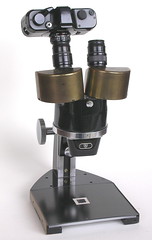Difference between revisions of "Scientific cameras"
(New base page created as a distribtor page for the specilised cameras) |
Hanskerensky (talk | contribs) m (typo) |
||
| (One intermediate revision by one other user not shown) | |||
| Line 1: | Line 1: | ||
| + | {{glossary}} | ||
{{stub}} | {{stub}} | ||
| Line 10: | Line 11: | ||
}} | }} | ||
| − | FIlm was regarded as one of the main storage media to record scientific observations. While normal cameras could be used for most of the field and laboratory documentation, some applications such as microscopy, x-ray, and later the recording of images created by electronics (such as on | + | FIlm was regarded as one of the main storage media to record scientific observations. While normal cameras could be used for most of the field and laboratory documentation, some applications such as microscopy, x-ray, and later the recording of images created by electronics (such as on oscillographs) required specialised camera designs. Often, as in the case of microscope cameras, standard camera bodies could be adapted. |
Examples of scientific cameras are: | Examples of scientific cameras are: | ||
Latest revision as of 05:07, 4 June 2021
Glossary Terms
This article is a stub. You can help Camera-wiki.org by expanding it.

|
| stereo photo micrography with the auto 110 image by Rick Oleson (Image rights) |
FIlm was regarded as one of the main storage media to record scientific observations. While normal cameras could be used for most of the field and laboratory documentation, some applications such as microscopy, x-ray, and later the recording of images created by electronics (such as on oscillographs) required specialised camera designs. Often, as in the case of microscope cameras, standard camera bodies could be adapted.
Examples of scientific cameras are:
- Microscope cameras
- X-Ray cameras
- Oscillograph cameras
- eg. Cossor 1428